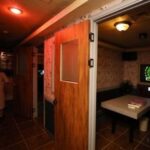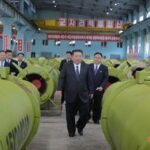Kim Jong Un’s Big Tourism Bet: Can North Korea Overcome Sanctions and Build a Thriving Industry?
wikitree Views
North Korea is working to revive its tourism industry, which has been halted due to the COVID-19 pandemic, to generate foreign currency. Kim Jong Un demonstrates his commitment to the sector by inspecting soon-to-be-opened facilities in the Kalma Coastal Tourist Area in Wonsan, Kangwon Province. However, experts warn that attracting tourists, particularly from China and Russia, could prove difficult due to the exclusion of South Korean visitors and the lack of adequate transportation infrastructure.

Kim Jong Un (left) tours a hotel in the newly completed Kalma Coastal Tourist Area in Wonsan City with his daughter Kim Ju Ae on December 29. /Korean Central News Agency, Yonhap
The Korean Central News Agency reported that Kim visited the Kalma Coastal Tourist Area on Sunday with his daughter, Ju Ae. After touring the completed hotels, he expressed satisfaction: “It’s more impressive and beautiful the more I see it. “He noted that the area has been developed to a level where important national diplomatic events and political-cultural functions can be held with dignity. The Kalma area is scheduled to open in June.
Kim highlighted the importance of the Kalma Coastal Tourist Area, calling it a vital first step in the country’s efforts to advance its tourism industry. He instructed officials to establish a tourism and cultural zone linking the Mount Kumgang Tourist Area with Kalma and to focus on developing regional tourism resources, including mountain tourism in the Samjiyon area.
The development of the Kalma area, a coastal city centered around Myongsa-sipri’s long white sandy beach, began in 2014. Although initially set to be completed by 2019, the project faced delays due to international sanctions and the pandemic. Work picked up pace after Kim’s visit last July, and he has now visited the area six times, underscoring his strong interest.
North Korea is also improving its transportation infrastructure to support the revival of its tourism industry. Last month, Air Koryo, North Korea’s national airline, landed a passenger plane at Shanghai Pudong International Airport for the first time in five years, hinting at the possible return of the Pyongyang-Shanghai route. The country is also in talks with Russia to establish a tourism agreement allowing group tourists to enter and is planning to resume passenger train services between North Korea and Russia.
While North Korea hopes to attract foreign tourists, especially from Russia, the challenges are considerable. Following the suspension of tours to Mount Kumgang, North Korea has aimed to bring in visitors from China and Russia, but poor transportation options and high travel costs have hindered success. Experts argue the area will struggle to compete as a viable destination without South Korean tourists.
Many South Korean facilities in the Mount Kumgang area have been dismantled. According to the Ministry of Unification, major structures, except for the separated family meeting hall, have been removed. Since Kim’s order to demolish South Korean facilities in 2019, the prospects for inter-Korean tourism cooperation have grown increasingly dim.
As North Korea prepares to open the Kalma area this summer and hopes to attract international conventions, it remains unclear whether these efforts will lead to tangible results.















Most Commented